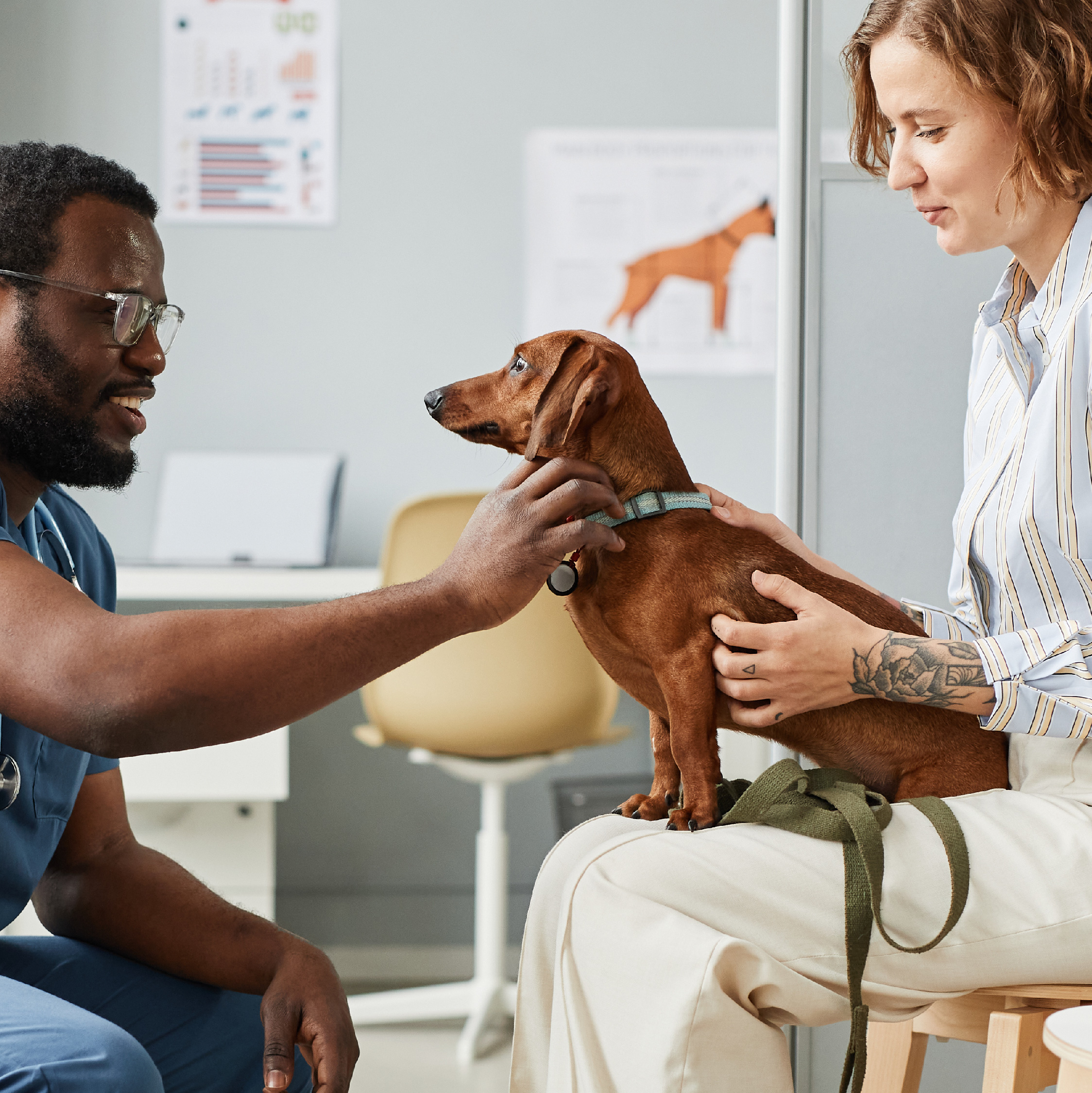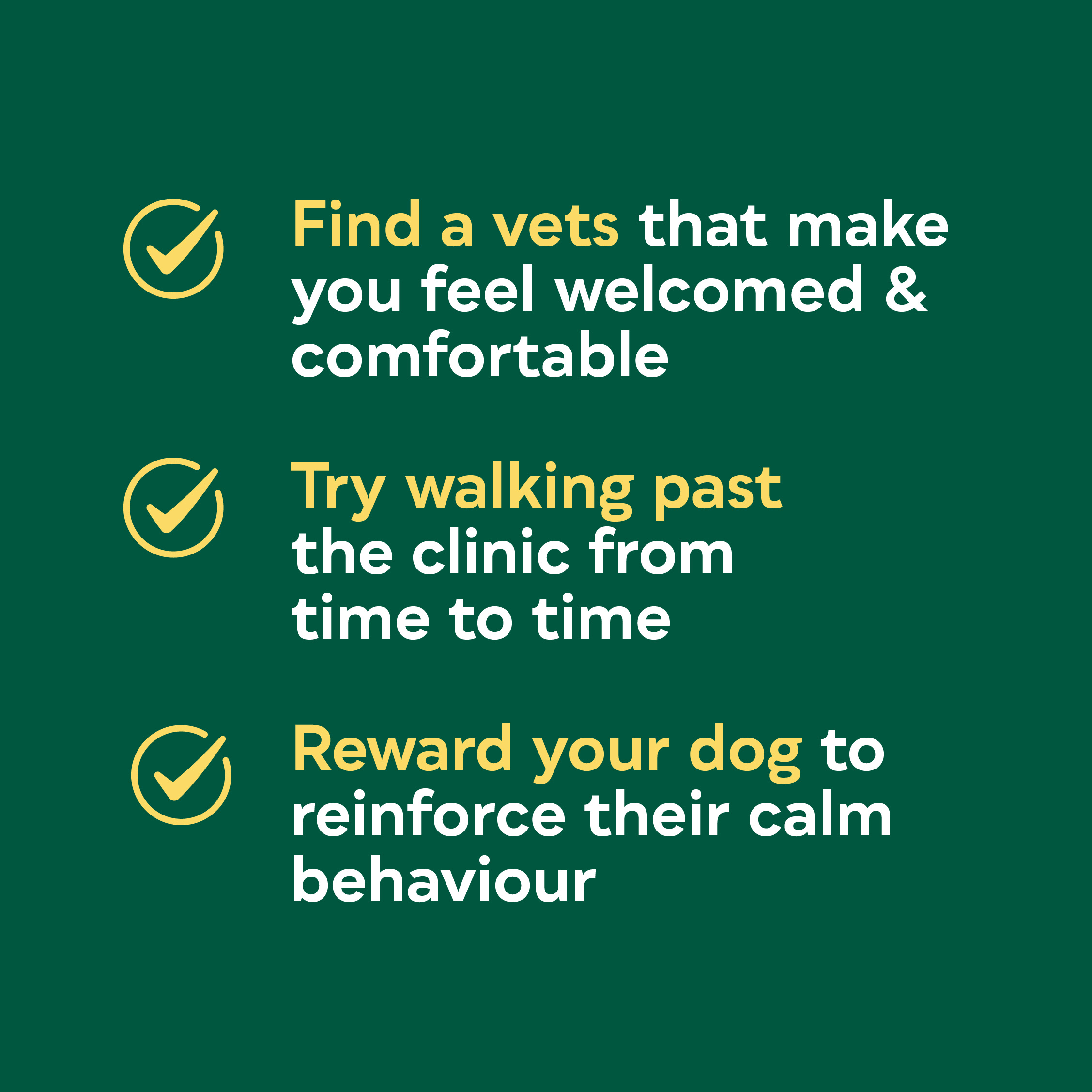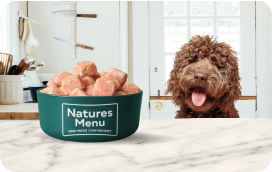VISITING THE VET AND HOW TO CALM A STRESSED OR ANXIOUS DOG
Table of Contents:
Choosing a vet
- Can I register with more than one vet
- In case of emergency…
Building a relationship with your vet
Getting young dogs used to the vet
- The importance of puppy classes
- Positive reinforcement
How to calm a stressed or anxious dog at the vet
- Desensitisation – repetition & reward
- Treats vs toys
Waiting room etiquette
After each vet visit
Taking your dog to the vet FAQs
- Can I register with more than one vet?
- How should I choose a vet?
- How do I get my dog used to the vets?
- How can I calm my anxious dog at the vets?
- How often should I take my dog to the vet?
- Who should my vet be associated with?
- How do I check if my vet provides out-of-hours care?
- What should I do in an emergency?
In a nutshell…
Trips to the vet are a regular part of looking after your dog. But whether it’s boosters or flea medicine, check-ups or treatment, there’s no reason why the experience shouldn't include some positivity. So in this guide, we explore how to set you and your four-legged friend up for success from puppyhood, as well as how to calm a stressed or anxious dog, whatever their age.
Choosing a vet
Finding a vet you and your dog feel comfortable with is really important. So choose one you trust and feel able to visit whenever you need to, in a way that’s calm and stress-free. Recommendations from friends and family are a great place to start, but it’s also worth having a quick chat with the practice staff so you can ask any questions you may have. Ideally you want someone welcoming and happy to give their time, so that when you come away from the clinic, you feel they’re someone you’d be comfortable leaving your dog with.
Can I register with more than one practice?
You might have never even considered this (many pet parents haven’t) but there’s absolutely no harm in registering with more than one vet. Just think about any friends or family who live far away and who you stay with for more than a few days. You never know, having your dog registered at a vet nearby might just come in handy one day, and all practices can call other vets to ask for copies of medical notes if they need to.
TIP
The chances are you’ll have nothing but good things to say about your vet throughout your dog’s life. But if you do ever have a bad experience, don’t be afraid to switch. You have ultimate care over your dog, so trust your instincts and do what you feel is right.
In case of emergency…
Hopefully you’ll never need to make a call to the emergency vet. But just in case, the next best thing is knowing where the closest clinic is and what number to ring. Not all vets offer out-of-hours cover at their own practice, so you may need to travel elsewhere outside of normal opening times. Make a note and keep the details somewhere you’ll find easily – like your mobile phone. Even if you never need them, it’s good to know they’re there.
Building a relationship with your vet
Having a good relationship with your vet is a big part of helping you and your dog feel happy during visits. To build rapport, go in as often as reasonably possible and just pay a visit to the waiting room. This will help you create more positive interactions for your dog to remember. Everything from veterinary staff making a fuss of your dog to a cheeky treat from the receptionist, can all help show your dog that the vet is nothing to be scared of.
 Getting young dogs used to the vet
Getting young dogs used to the vet
When it comes to training your dog, the earlier you start the better – and the same goes for visiting the vet. Many people often wonder ‘How often should I take my dog to the vet?’ but when they’re puppies it can feel like the opportunities just keep coming, so take full advantage. At a young age, your pup has no bad associations with the vet, so all you need to focus on is creating good ones. Popping in to have a weigh-in once per week or even just to say hi and show the staff how much they have grown can really help create positive associations.
The importance of puppy classes
Although not technically a vet visit, puppy classes are a great place to start getting your dog used to things they’ll likely experience when they do pop in for a check-up or vaccination. For example, as well as being valuable ways of teaching behaviours and socialising your dog, puppy classes also help your dog get used to having things like their paws and ears checked.
Positive reinforcement
The simple fact is, a vet clinic – with all its sights, sounds and smells – can send your dog’s senses into overdrive. Especially when they’re a puppy. And an overstimulated dog is not a calm dog. So one thing you can do is introduce them to the experience slowly. Try walking past the clinic from time to time. Then occasionally you could drop in to say ‘hi’ and get some fuss from the staff in the waiting room. If you’re feeling adventurous, you can even try a scale for size! Just remember to reward your dog at every stage to reinforce their good (calm) behaviour and create a positive experience around each visit.
How to calm a stressed or anxious dog at the vet
If you’re wondering how to calm a stressed or anxious dog during a visit to the vet – or if it’s even possible for your four-legged friend – there is hope. Helping dogs reduce or overcome their fears is all about taking time and getting them used to the experience, bit by bit.
Desensitisation – repetition & reward
Start small, even outside the practice before your dog shows obvious signs of anxiety or stress. Keep them relaxed by using a toy or treats to give positive associations with the area or entrance point. You can begin by doing something as simple as walking past the vets, then going up to the door, then going in, then walking to and from a consultation room. While you’re building your dog’s confidence, it’s worth taking them to the vets for any training they may also offer outside of check-ups and treatments. Otherwise, it might be too much too soon.
Treats vs toys
As with any dog training, high-value rewards will likely produce better results. So choose a reward your dog loves. Perhaps it’s their favourite food, maybe it’s their favourite ball. Either is absolutely fine, you know them best and how best to get their full attention. So use it to your advantage! You can even take your dog’s much-loved toy into the waiting room to build up the positivity.
Waiting room etiquette
When it comes to the waiting room at the vet, it’s good to always remember that it isn’t the park and different rules apply. It may sound obvious, but knowing what to do and what not to do can be tricky if you or your dog are feeling anxious. And even if your dog is comfortable, it’s important to be sensitive to the fact that others may not be. So here are a few pointers to help:
Dos & Don’ts
Do…
- Find space for you and your dog, away from other people and their pets
- If your dog is feeling anxious or the waiting room is busy, just let the receptionist know you’ll wait outside or in your car
- Try to stay relaxed – dogs can often feel any tension on the lead
- Take some treats and reward good (calm) behaviour
Don’t…
- Force your dog to do anything they’re uncomfortable with as it’ll only heighten their anxiety. For example, don’t force your dog to sit if they want to stand
- Say “hi” to any dogs you know – your dog may react differently under stress
- Let your curious dog sniff around other dogs (or cats, rabbits, guinea pigs or birds!)
- Feel embarrassed to take your dog outside if their anxiety doesn’t settle or worsens
After each vet visit
When you’re thinking about how to calm your stressed or anxious dog at the vet, it’s easy to focus on the build-up and the time spent at the clinic, and then forget about afterwards. But positive reinforcements have their place post-visit too!
Try going somewhere they love on the way home, whether that’s a trip to the park or the pet store. Then have plenty of playtime. It’ll do wonders for de-stressing both of you, as well as help build even more positive associations with the vet.
 Taking your dog to the vet FAQs
Taking your dog to the vet FAQs
Can I register with more than one vet?
Yes! In fact, if you tend to go away for a few days visiting friends and family, it can be a great idea to register with a vet near each of these locations, just in case.
How should I choose a vet?
There are lots of things to think about when choosing a vet – from the location of the clinic to the friendliness of the staff. But a good place to start is with recommendations from friends and family.
How do I get my dog used to the vets?
Getting your dog used to regular vet visits is all about positive reinforcement. A great time to start is when they’re a puppy. But even if you have an older dog who gets anxious at the vets, there are still plenty of ways you can help boost their confidence.
How can I calm my anxious dog at the vets?
If you have a dog that gets stressed or anxious about visiting the vets, don’t worry – you’re not alone. It’s a common problem that can be helped with techniques aimed at desensitising your dog to triggers, using positive reinforcement, and plenty of patience.
How often should I take my dog to the vet?
There’s no right or wrong answer to this question and in fact the frequency of your vet trips will depend on a number of things. For example, are your visits health related? If so, go as often as you need to. If they’re training related, then let your dog be your guide. You want to go often enough to get them used to it, but gradually, so you can build on positive experiences without overdoing it.
Who should my vet be associated with?
Most reputable vets will be able to advise you on other dog-related services outside of healthcare. For example, your vet should be able to recommend everything from good puppy schools nearby to reliable pet insurance companies. Many even support local animal charities.
How do I check if my vet provides out-of-hours care?
The best way to check this is either by visiting the clinic’s website or simply calling the clinic and asking. They’ll be able to tell you exactly what services are available and what number to ring in case of an emergency.
What should I do in an emergency?
Hopefully you’ll never find yourself in this situation, but if you do, it’s good to know what to do. If an emergency trip to the vet is needed, always try to ring ahead to let them know you’re coming. That way they can prepare for your arrival. This is true whether you’re visiting your usual clinic or an out-of-hours service.
In a nutshell…
Although visiting is a regular part of caring for your dog, many pet parents find themselves wondering how to calm a stressed or anxious dog at the vet. But with a few techniques using positive reinforcement and plenty of patience, there’s no reason why these worries can’t be overcome. Getting your dog used to the vet when they’re young is the best way to set them up for success. But even with older dogs, taking time to desensitise them to a vet visit – gradually – can do wonders for their confidence. Following the points mentioned above should put you and your dog more at ease.








 Getting young dogs used to the vet
Getting young dogs used to the vet Taking your dog to the vet FAQs
Taking your dog to the vet FAQs